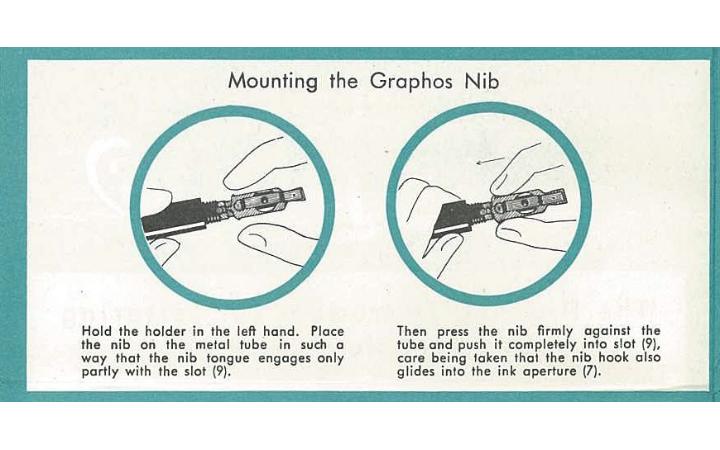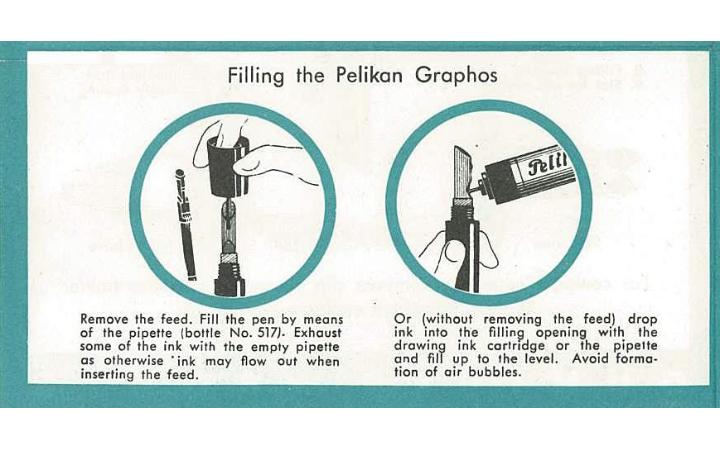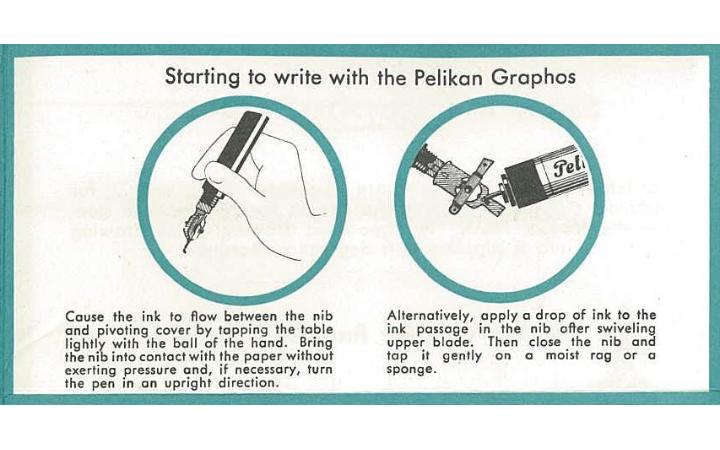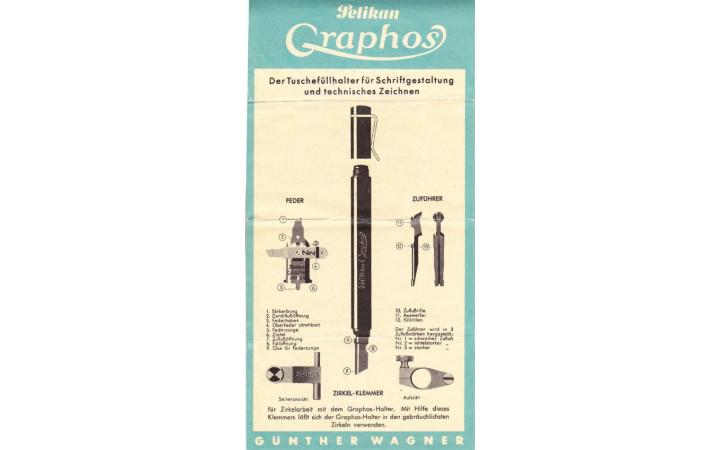Drawing pens (fountain pens for technical drawings and calligraphy)
In 1934 (quite early in the development of such drawing instruments) Pelikan developed a drawing pen to meet the requirement for technical drawings with long, smooth lines. The pen could hold a larger amount of ink and feed it continuously to the nib.
Pelikan GRAPHOS
The first pen for technical drawings, the GRAPHOS consisted of a pen, the barrel of which could be filled with ink. The tip ended up in a tube (called the ejector), which could accommodate a variety of nibs. There was a large number of nibs available, depending on the use for which they were needed. The nib was supplied with ink through the feeder, which reached through the ejector into the holder. To fill the pen with ink, the feeder was taken out of the ejector and then the ink was inserted through the opening with an eyedropper.
The first GRAPHOS were still made of hard rubber, which was later replaced by plastic.
| Model | Production Period | Nib |
|---|---|---|
| GRAPHOS | 1934-1969 | Steel |
| Weight | Total Length | Barrel Length | Cap Length | Diameter | Ink Capacity |
|---|---|---|---|---|---|
| 0.31 oz | 4.31 in | 4.00 in | 1.18 in | 0.39 in | 1.6 ml indian ink |
| 8.8 g | 109.5 mm | 101.5 mm | 30 mm | 10 mm |
GRAPHOS
Previously unknown, old Graphos model. Referred to as Graphos “Mystery” by its owner. The cap is pushed on and not screwed on. made of hard rubber or ebonite.
As a distinction to the usual Graphos holders this specimen has a metallic portion (about 7 mm wide), which then merges into the barrel from plastic. This metal part is not just a decorative ring, but massively. While the barrel serves as the ink reservoir at the Graphos previously known, the ink reservoir ends with this pen in the metal part. A round metal mandrel then establishes the further connection to the end of the solid plastic. The depth of the ink tank thus is reduced from 69 mm to 21 mm, the ink absorption of 1.6 ml to 0.5 ml.
Rotring GRAPHOS
The rotring Werke Riepe KG in Hamburg were originally founded in 1928 by Wilhelm Riepe and Erich Barthe. After the success of the Tintenkuli as a writing instrument was the further development named Rapidopraph and issued in the year 1956. Now, instead of ink, india ink flowed through the tube for technical drawings. At the beginning of the 1970s, Pelikan joined the family business and acquired a 50% stake in the company. Rotring expands its product range with the GRAPHOS. After Pelikan had to declare bankruptcy in 1982, the company returned the share of rotring back to the family business.
The rotring GRAPHOS was a further development of the Pelikan GRAPHOS. The grip can be separated from the long barrel. So it could now be screwed into a circular approach.
This new form of GRAPHOS was distributed only via rotring in Germany and Europe. The identical model for the American continent was produced under the name GRAPHOS GE1 by the Pelikan plants in Mexico.
| Model | Production Period | Nib |
|---|---|---|
| GRAPHOS | Stahl |
| Weight | Total Length | Barrel Length | Cap Length | Diameter | Ink Capacity |
|---|---|---|---|---|---|
| 0.34 oz | 5.08 in | 4.21 in | 1.30 in | 0.41 in | 0.5 ml |
| 9.7 g | 129 mm | 107 mm | 33 mm | 10.5 mm |
Pelikan GRAPHOS GE 1
An improved development of GRAPHOS was prepared in the Pelikan plant of Mexico. The function with ejector to accommodate the nib and feeder of the ink was unchanged. Now, there was a feeder with ramp metering: weak, moderate and severe inflow. New was the separation of the long barrel from the grip. By turning outside the grip section, the container for receiving the ink is visible.
The GRAPHOS GE 1 was probably only sold in America.
| Model | Production Period | Nib |
|---|---|---|
| GRAPHOS GE 1 | Stahl |
| Weight | Total Length | Barrel Length | Cap Length | Diameter | Ink Capacity |
|---|---|---|---|---|---|
| 0.34 oz | 5.08 in | 4.21 in | 1.30 in | 0.41 in | 0.5 ml |
| 9.7 g | 129 mm | 107 mm | 33 mm | 10.5 mm |
Pelikan GRAPHOS G2
With the introduction of ink cartridges the GRAPHOS was fundamentally redesigned. The barrel could accommodate 2 ink cartridges. Instead of a nib, a nozzle (mouthpiece) was screwed on to the front end of the grip section. The nozzle could be changed quickly and without much effort. Thre were many different nozzles available for writing or line drawing.
| Model | Production Period | Nib |
|---|---|---|
| GRAPHOS G2 | 1960-1981 | Steel |
| Weight | Total Length | Barrel Length | Cap Length | Diameter | Ink Capacity |
|---|---|---|---|---|---|
| 0.36 oz | 5.14 in | 4.61 in | 2.44 in | 0.43 in | 2 x 0.8 ml (cartridge) |
| 14.2 g | 130.5 mm | 117 mm | 62 mm | 11 mm |
GRAPHOS G2
Pelikan technos
A further development of GRAPHOS G2 was the 'Pelikan technos'. The substantial improvement is the cleaning wire inside the thermic-regulator. He prevented the mouthpiece that had received the set screw nozzle clogged by dried ink.
| Model | Production Period | Nib |
|---|---|---|
| technos | 1969- | Steel |
| Weight | Total Length | Barrel Length | Cap Length | Diameter | Ink Capacity |
|---|---|---|---|---|---|
| 0.50 oz | 5.43 in | 4.78 in | 2.54 in | 0.47 in | 2 x 0.8 ml (cartridge) |
| 14.2 g | 138 mm | 121.5 mm | 64.5 mm | 12 mm |
technos
Pelikan E-Technik
While you had to replace the nozzle at Pelikan technos when the line width should be changed, E-Technik had available technical pens for each line width. The ink filling uses no longer replaceable cartridges, but a transparent plastic tank that can be refilled directly. The nozzles allow a precise drawing and writing in the respective line width.
The use of ink pens in technical occupations has today been replaced by computer programs (CAD) created technical drawings.
In Spain a penbox ET / 2500 (Estuche technico escolar) was sold for technical drawing at school in the 1990s. Inside there are three Pens Pelikan E-Technik. At the penbox belongs also a yellow filler with "Dauerfeder" as it is represented here as well.
Originally, the company Laurin from Waiblingen had conquered the student market in Spain with their simple and inexpensive writing instruments. In the early 1970s, Laurin is taken over by Pelikan. For a long time writing pens will continue to be marketed under the name Laurin with the addition of 'an article by Pelikan' until the name Laurin is replaced by the name Pelikan. But in the plant in Waiblingen there were never own writing instruments manufactured. Mostly they were made on behalf of Laurin and later Pelikan by the company Mutschler in Heidelberg.
Thus, identical models without manufacturer specifications are found, which differ only slightly (clip and designation of the character strength) from each other (see picture) or even a largely identical pens of the company Reform. Reform is the subsidiary of Mutschler, under whose name its own products are marketed.
| Model | Production Period | Nib |
|---|---|---|
| E-Technik |
| Weight | Total Length | Barrel Length | Cap Length | Diameter | Ink Capacity |
|---|---|---|---|---|---|
| 0.39 oz | 4.98 in | 4.02 in | 1.34 in | 0.45 in | 0.5 ml |
| 11.1 g | 126.5 mm | 102 mm | 34 mm | 11.5 mm |
E-Technik
For a good exchange the forum The Fountain Pen Network - FPN.



























































































